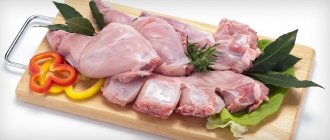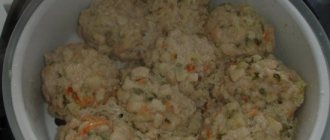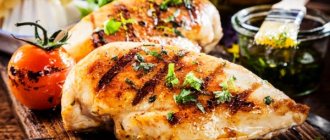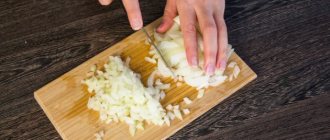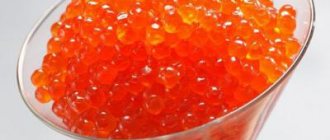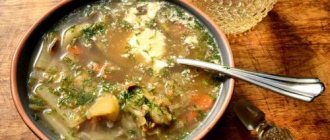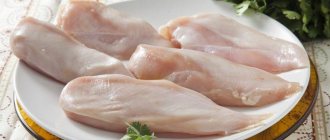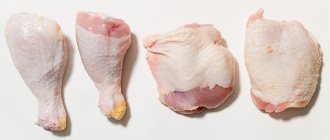What are the benefits of rabbit meat?
Rabbit meat is considered white and is one of the most dietary products, therefore it is highly valued. The dietary properties of rabbit meat lie primarily in the high content of easily digestible protein, while there is very little fat in it. As a result, almost any dish prepared from rabbit turns out to be a real delicacy and can satisfy even the most demanding taste.
It has a pleasant taste and subtle aroma. Meat is easily digested by the human body. Unlike any other meat, it contains the least cholesterol and fat, and, on the contrary, more proteins. Rabbit meat helps maintain normal fat metabolism and nutrient balance in the body, so nutritionists advise using it more often in your diet. Wild rabbit meat is darker and more flavorful than domestic rabbit meat.
The meat of old animals needs to be marinated and stewed for a long time. It makes excellent roast, jelly, stew or rabbit in white sauce.
Forelegs, neck and shoulder blade. These parts of the carcass are used to prepare stews or bases for sauces.
Back and abdomen. The back of the rabbit makes an excellent roast, while the belly is separated, cut into small pieces and used to make sauce.
Rabbit hind legs are often sold separately. They are used to prepare roasts and stews.
The dietary properties of rabbit meat are the reason why doctors recommend this meat to children, including as first complementary foods, to the elderly and the sick. You can prepare a huge number of dishes from rabbit meat: excellent main courses, broths and soups.
It has long been noted that the systematic inclusion of rabbit meat in the daily menu (of course, within reasonable limits) has a beneficial effect on metabolic processes and maintains the necessary balance of nutrients. It is no coincidence that rabbit meat is recommended for the following ailments:
- gastritis.
- ulcer of the stomach and duodenum.
- colitis and enterocolitis.
- hypertension.
- atherosclerosis.
- diabetes.
- all kinds of diseases of the liver, biliary tract, heart, gastrointestinal tract and kidneys.
- various types of allergies (except allergies to rabbit meat itself).
For long-term storage, rabbit meat is salted and smoked, and salting is usually used for subsequent smoking.
Rabbit meat has very little fat, so if cooked incorrectly it becomes dry. That's why it's best to bake or stew it, or fry it to a thin pink crust, giving it the opportunity to cook in its own juices.
Calorie content of minced rabbit
Minced rabbit is the flesh of a rabbit that has been ground using a knife, food processor or meat grinder. Rabbit meat is a dietary product, characterized by a balanced vitamin and mineral composition and a high content of animal protein, which is completely absorbed by the human body. People suffering from allergic reactions should consume minced rabbit.
The chemical composition of minced rabbit contains: vitamins A, E, C, B2, B1, B6, B12, B9, choline, as well as mineral elements: phosphorus, cobalt, calcium, potassium, magnesium, sodium, molybdenum, fluorine, selenium, zinc, chromium, iodine, manganese, copper, sulfur, chlorine, iron.
The calorie content of minced rabbit is 147 kcal. The composition contained proteins - 19.5 g, carbohydrates - 0.7 g, fats - 7.4 g.
Among the most interesting recipes for minced rabbit dishes is terrine with pistachios. A juicy, aromatic and delicate soufflé, which is baked in a bacon “crust,” requires a lot of work, but it will all pay off as soon as you serve this excellent culinary delight on the holiday table.
To prepare terrine, you will need minced rabbit, flour, garlic, minced pork, fragrant marjoram, cream, egg, dry white wine and a little cognac. The ingredients are mixed, then you need to add peeled pistachios and put the resulting mixture in a rectangular shape, where you first need to place overlapping pieces of bacon. Press the minced meat tightly into the mold, cover with bacon on top and bake in the oven for 2-2.5 hours at 170 °C. Place a container of water in the oven. At the end, cool the terrine, turn it onto a plate and serve with green salad leaves.
Minced rabbit is great for meatballs, cutlets and filling pies. The dishes that come out of it are airy and tender.
Calorie content of rabbit kidneys
A rabbit is a miniature animal, a member of the hare family. Rabbit meat is considered dietary, very useful for the nutrition of people in the period after illness. Many chefs like to include dishes made from the meat of this animal in their menus; the rabbit enjoys special respect in Spain and France.
From time immemorial, rabbit kidneys have been considered a delicacy, even given their barely noticeable specific smell, which can be eliminated by soaking them in water and cooking them in several waters.
The chemical composition of rabbit kidneys includes: vitamins B2, B1, B12, B9, A, PP, C, as well as mineral elements: phosphorus, iodine, calcium, potassium, sodium, magnesium, sulfur, chlorine, iron, selenium, zinc.
The calorie content of rabbit kidneys is 66 kcal. The composition also contains proteins - 12.5 g, fats - 1.8 g.
In principle, it will be possible to prepare rabbit kidneys, as in the case of other offal. They can be baked, fried, boiled and stewed. “Twisted rabbit kidneys” were served at noble tables in Rus'. In the rabbit fricassee recipe, rabbit kidneys are a mandatory ingredient. To truly surprise your loved ones, please them with rabbit kidney julienne.
Rabbit kidneys, pre-soaked for a couple of hours in milk or water, boil and cut into strips. Also cut the champignons and fry them with plenty of onions, add the kidneys themselves and a little flour. Then cream or milk comes into play, which must be added in small portions, stirring constantly. Place portions in cocotte makers or other forms; you can sprinkle grated cheese on top and place them in the oven before baking the cheese. You can also use sour cream instead of cream or milk; in this case, the flour should be diluted with water.
Calorie content of rabbit liver
The rabbit is a small mammal from the hare family. The meat of this animal is dietary; it is often prescribed to children, the elderly and pregnant women, as it is characterized by a unique healing effect.
Rabbit liver is also a dietary product, and therefore it can and should be included in your diet. The bottom line is that rabbit livers are not so easy to buy; at farmers markets you have to “catch” rabbit livers, since they are taken apart first, and only a small liver can be obtained from one animal.
The calorie content of rabbit liver is 166 kcal. The composition also contains proteins - 19.0 g, fats - 10.0 g.
The chemical composition of rabbit liver is so enriched with vitamins that one serving of the finished product contains as many vitamins as can be contained in several vitamin tablets. It contains: beta-carotene, choline, vitamins A, C, E, D, H, PP, K, B2, B1, B6, B5, B12, B9, as well as mineral elements: phosphorus, nickel, calcium, potassium, magnesium, sodium, cobalt, tin, selenium, zinc, molybdenum, fluorine, manganese, copper, chromium, iodine, chlorine, iron, sulfur.
Many different and very healthy dishes are made from rabbit liver. Rolls, cutlets with oatmeal flakes, warm salads, cream soup. The quickest way is to fry the rabbit liver; it comes out tender and tastes wonderful, juicy inside and a little pinkish. Connoisseurs are advised to soak the liver in milk before cooking, but if the rabbit was raised at home, this does not need to be done.
One of the traditional dishes made from rabbit liver is pate. There are a lot of recipes for its preparation: pate with lard or egg, nuts or mushrooms, with shallots or carrots, each of the options will delight you with its extraordinary tenderness and creamy structure.
Recipe? Recipe!
What can you cook with rabbit meat? Here are some recipes:
Rabbit meat with dried porcini mushrooms:
Ingredients: 1 kg rabbit meat (with bone), 50 g porcini mushrooms (dried), 200 g mayonnaise, 50 g fat, 1 carrot, 2 onions, 1 bunch of parsley, 1 bunch of dill, 3-4 black peppercorns, bay leaf , ground pepper, salt.
Method of preparation: Peel the onions and carrots, wash and finely chop.
Wash the parsley and dill and chop them.
Wash the rabbit meat, chop into pieces of 50–70 g, add salt and pepper, place in a cauldron, fry in fat until golden brown, pour in a little water. Add pre-soaked mushrooms, bay leaves, peppercorns, onions, carrots and simmer for 20 minutes. Add mayonnaise and simmer until done. When serving, sprinkle with parsley and dill.
Rabbit meat with pickled vegetables:
Ingredients: 500 g rabbit meat, 4 cucumbers (pickled), 3 green tomatoes (pickled), 100 g zucchini (pickled), 200 g green peas (canned), 200 g sour cream, 4 potatoes, 2 teaspoons 3% vinegar , pepper, salt.
Method of preparation: Chop cucumbers, zucchini and tomatoes. Wash the potatoes, peel and cut into cubes.
Wash the rabbit meat, salt, sprinkle with vinegar, cut into thin slices, place in a cauldron, add potatoes, green peas, cucumbers, zucchini and tomatoes, pepper, add sour cream. Simmer until done.
Rabbit meat with Korean carrots:
Ingredients: 1 kg of rabbit meat, 200 g of Korean carrots, 100 g of fat, 200 g of mayonnaise, 3 onions, bay leaf, pepper, salt.
Method of preparation: Peel the onion, wash and finely chop. Wash the rabbit meat, cut into portions, salt and pepper, place in a cauldron, fry in fat until golden brown, add onions, Korean carrots, bay leaves, mayonnaise and add water so that the liquid covers the contents by no more than ½. Simmer until done.
Rabbit in mayonnaise:
Ingredients: 400 g rabbit meat, 50 g lard, 100 g mayonnaise, juice of 1 lemon, pepper, salt.
Method of preparation: Wash the meat, cut into large pieces, salt and pepper, pour in lemon juice, leave for 20 minutes. Place the lard in a cauldron, fry until the fat is rendered, add the meat and fry. Add mayonnaise, simmer until done.
Rabbit in red wine:
Ingredients: 1 rabbit carcass, 200 g of bacon, 3 onions, 700 ml of red wine, 200 ml of apple cider vinegar, 3 carrots, 50 g of flour, 3 cloves, ¼ teaspoon of caraway seeds, 2 cloves of garlic, 10 allspice peas, bay leaf, salt.
Method of preparation: To prepare the marinade, wash, peel and finely chop the carrots. Peel the garlic, wash it, crush it. Pour wine mixed with vinegar over carrots and garlic, add bay leaf, cumin, cloves, allspice and salt, pour in a little water, bring to a boil, add flour, stir and heat over low heat for 5 minutes. Cool the marinade.
Wash the rabbit carcass, chop it, pour in the marinade and leave for 2-3 hours at room temperature, then keep for another 3 hours in a cool place. Remove the meat and strain the marinade.
Peel the onion, wash it, finely chop it. Finely chop the bacon, place in a cauldron, fry until the fat has rendered, add onion and meat, fry. Pour in the marinade and simmer until done.
Compound
It is customary to consider the composition in the form of the main macroelements that make up meat, as well as microelements present in small quantities. The data was kindly shared by the Institute of Nutrition of the Russian Academy of Sciences. Macronutrients:
- 100 g of rabbit meat contains 24.767±0.005 mg of magnesium;
- 224.668±0.005 mg of sulfur is also present;
- in addition there is 19.669±0.005 mg of calcium;
- found 79.477±0.005 mg of chlorine;
- 56.108±0.005 mg sodium detected;
- 189.811±0.005 mg of phosphorus was detected;
- and measured 334.249±0.005 mg potassium.
There is data on the presence of microelements:
- 3.289±0.005 mg of iron was detected in 100 g of rabbit meat;
- 4.419±0.005 μg molybdenum present;
- 2.304±0.005 mg of zinc was detected;
- found 0.007±0.005 mg of manganese;
- 4.971±0.005 μg of iodine was detected;
- the presence of 8.462±0.005 μg of chromium was established;
- weighed 129.609±0.005 µg copper;
- determined 72.128±0.005 μg of fluorine;
- the presence of 16.113±0.005 μg of cobalt was established.
